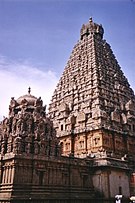The region of Tamil Nadu in modern India has been under continuous human habitation since prehistoric times, and the history of Tamil Nadu and the civilization of the Tamil people are among the oldest in the world. Throughout its history, spanning the early Paleolithic age to modern times, this region has coexisted with various external cultures. Except for relatively short periods in its history, the Tamil region has remained independent of external occupation.
 |
The four ancient Tamil empires of Chera, Chola, Pandya and Pallava were of ancient origins. Together they ruled over this land with a unique culture and language, contributing to the growth of some of the oldest extant literature in the world. They had extensive maritime trade contacts with the Romanempire. These three dynasties were in constant struggle with each other vying for hegemony over the land. Invasion by the Kalabhras during the 3rd century disturbed the traditional order of the land by displacing the three ruling kingdoms. These occupiers were overthrown by the resurgence of the Pandyas and the Pallavas, who restored the traditional kingdoms. The Cholas, who re-emerged from obscurity in the 9th century by defeating the Pallavas and the Pandyas, rose to become a great power and extended their empire over the entire southern peninsula. At its height the Chola empire spanned almost 3,600,000 km² (1,389,968 sq mi) straddling the Bay of Bengal. The Chola navy held sway over the Sri Vijaya kingdom in Southeast Asia.
Rapid changes in the political situation of the rest of India due to incursions of Muslim armies from the northwest marked a turning point in the history of Tamil Nadu. With the decline of the three ancient dynasties during the 14th century, the Tamil country became part of the Vijayanagara Empire. Under this empire the Telugu speaking Nayak governors ruled the Tamil land. The brief appearance of the Marathas gave way to the European trading companies, who began to appear during the 17th century and eventually assumed greater sway over the indigenous rulers of the land. The Madras Presidency, comprising most of southern India, was created in the 18th century and was ruled directly by the British East India Company.
 A temple from the Chola period. The Cholas united most of the south Indian peninsula under a single administration during the tenth and the eleventh century CE.
A temple from the Chola period. The Cholas united most of the south Indian peninsula under a single administration during the tenth and the eleventh century CE.
 Shore Temple in Mamallapuram built by thePallavas. (c. eighth century C.E.)
Shore Temple in Mamallapuram built by thePallavas. (c. eighth century C.E.)
 Tanjore became a major cultural centre during the 18th and 19th centuries, under Maratha rule. Figure depicts a Tanjore painting from this era.
Tanjore became a major cultural centre during the 18th and 19th centuries, under Maratha rule. Figure depicts a Tanjore painting from this era.  Brihadeshwara Temple.
Brihadeshwara Temple.
T




No comments:
Post a Comment